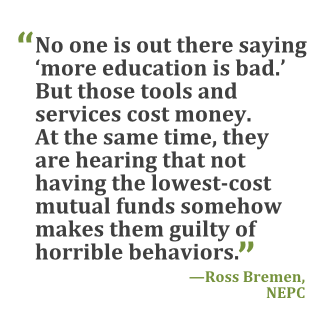An annual report on fees in defined contribution plans by investment consulting firm NEPC, which consults on $184 billion in plan assets, shows total retirement plan costs have hit another all-time low.
And for the first time in the study's 11-year history, the majority of retirement plan sponsor respondents report having a fixed, per-participant recordkeeping fee structure in place.
Since 2013, 81 percent of the 117 plan sponsor respondents report having renegotiated their recordkeeping fees; 51 percent of the plans in the survey, which had an average size of $1.1 billion in assets, now apply a per-participant fee for recordkeeping.
 Total investment management fees averaged 42 basis points, down from 57 basis points in 2006 and 46 basis points in 2014.
Total investment management fees averaged 42 basis points, down from 57 basis points in 2006 and 46 basis points in 2014.
Average recordkeeping costs were $57 per participant last year, down from $92 in 2011.
Ross Bremen, a partner at Boston-based NEPC, expected fees to show some leveling in this year's report.
“While lower fees reflect the good work sponsors have done to reduce fees on participant's behalf, at some point service levels could suffer,” said Bremen in a statement accompanying the report. “A race to the bottom, at the risk of sacrificing service and innovation, is not in the participants' best interests.”
In an interview, Bremen noted another recent NEPC survey of sponsor clients, which showed plan fees were a top concern.
“Fees are a front burner issue right now,” he said. “A lot of that has to due with the litigation we've seen in the corporate defined contribution space. Sponsors see the headlines.”
Overall lower costs for participants are a welcome trend, said Bremen.
But the trend to a strict per-participant fee structure for recordkeeping services is removing flexibility from plan design as a growing consensus of retirement experts, policymakers and participant advocates say savers need more personalized savings and decumulation strategies.
“The idea that recordkeeping is a commodity is just not the case,” said Bremen, who noted that 21 percent of surveyed plans do not use any revenue-sharing agreements to help shoulder the cost of plan services.
“There is a lot of talk about getting participants better services, and even personalized cradle-to-grave planning through financial wellness programs. And more participants are going to need personalized advice when it comes to spending their savings in retirement. The idea that recordkeeping is a bare-boned service doesn't completely square with the services so many people say participants need,” said Bremen.
No 'Perfect Plan'
To date, industry has yet to create the algorithm that quantifies the perfect mix of services to get participants safely to, and through retirement, noted Bremen.
Nor is there a smoking gun proving participants are being starved from the services they need, or that the race to lower plan fees is resulting in poorer savings outcomes.
But data does suggest sponsors see fixed per-participant recordkeeping fees as inherently cheaper than plans with fee schedules based on plan assets, and “that is just not the case,” says Bremen.
“No one is out there saying 'more education is bad,'” said Bremen. “But all of those tools and services cost money. At the same time, they are hearing that plan fees are too high, or that fees have to be level between participants, or that not having the lowest-cost mutual funds somehow makes them guilty of horrible behaviors.”
More and more, sponsors are footing the cost for a la carte plan services as they trend away from a reliance on variable recordkeeping fees and revenue-sharing agreements, explained Bremen.
For employers willing to do that, the out-of-pocket cost of sponsoring a plan is going up. And that introduces the risk that some sponsors will be reluctant to increase matching contributions. “How is that good for getting people prepared for retirement?”
Also notable in this year's Defined Contribution Plan and Fee Survey was sponsors' willingness to adopt in-plan annuities.
In 2012, annuities were virtually non-existent in plan menus. Now 5 percent of surveyed sponsors have included a lifetime income option.
NEPC has been supportive of annuity adoption, says Bremen. As a co-fiduciary, the firm is not paid on recommending any investment product. But even as more sponsors in the NEPC universe show a willingness to break the mold, broad-scale annuity adoption will likely require increased investment in participant education, another cost that will have to be paid for.
“There's no perfect annuity, no perfect fund, and no perfect plan—that's true of all products,” said Bremen. “What is important going forward is that plan fiduciaries have the flexibility to customize plans the way they think will be most beneficial to participants.”
© 2025 ALM Global, LLC, All Rights Reserved. Request academic re-use from www.copyright.com. All other uses, submit a request to [email protected]. For more information visit Asset & Logo Licensing.




